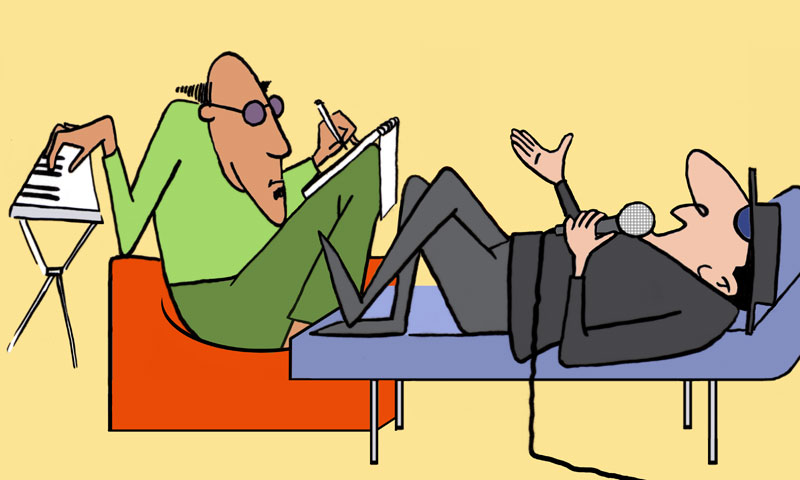Home » Jazz Articles » Mr. P.C.'s Guide to Jazz Etiquette and Bandstand Decorum » Solving the Audience Equation, The Fix is On, and It's a Setup!
Solving the Audience Equation, The Fix is On, and It's a Setup!

This whole "jazz musicians play thousands of chords to three people" vs. "rock musicians play three chords for thousands" thing: What is the correct chord/audience ratio?
Perhaps zero chords for an infinite audience is the ideal; or all chords for no audience. I certainly have landed closer to the latter.
Is art about this kind of calculus?
—Randy H., Atlanta
Dear Randy:
Let's break it down. We have a situation where as variable x (the number of chords) increases, variable y (the number of people willing to listen to the chords) decreases. The two variables are inversely related, so instead of a single "correct chord/audience ratio" we need a slightly more complex equation.
If we can (optimistically) speculate that an average jazz audience might be 50 people, then our equation is xy = 50. If there is one chord (x = 1), then y = 50; all 50 people will listen. If there are ten chords, only five of them will listen. And if there are 50 chords, just one person will listen: a misguided critic looking for the "next new thing."
But this overlooks the role of two additional variables. First, the complexity of the chords themselves: of those five people who would listen to ten chords, four of them would drop out if the chords were altered dominant jazz chords instead of rock triads. And the visual aspect: of those same five people who would listen to ten simple chords, four would quickly leave if the chords were played by old, broken down jazzers instead of healthy young rock studs.
Your original premise that "jazz musicians play thousands of chords to three people" gives us all hope; those three people —abnormally gifted in their capacity to withstand both harmonic intricacy and unsettling reminders of the human condition —are the music's lifeline.
Dear Mr. P.C.:
I just took my sax to the repairman and sounded much better afterwards. Couldn't I save a lot of practice time by just taking it to him more often?
—Reed, ME
Dear Reed:
I've been in this business long enough to recognize the signs of addiction: You take your sax to the repairman once and play better; soon you find yourself craving more. Before long it takes multiple repairs to give you that same bump, and the repairman jacks up his price knowing he's got you hooked. You're desperate for more fixes, but your jazz gigs won't cover the bills.
At that point you'll have just two choices: Will you turn to a life of crime to support your repair habit? Or will you become a repairman yourself, seeking out young players too naive to know what you've so painfully learned—that sounding good always comes at a price.
Dear Mr. P.C.:
I'm playing bass in a trio behind a singer. We're getting ready to start a tune, wondering what we'll do for an intro. The singer tells us "Give me eight bars up front," and the pianist turns to me and says "Let's play the first eight bars." But wouldn't the intro itself always be the first eight bars?
—Chris, Tacoma
Dear Chris:
Nothing your pianist said denies that the intro is always the first eight bars. By saying "Let's play the first eight bars" he's just supporting the vocalist, agreeing that eight bars is an ideal number and now is the perfect time to play them, regardless of their content.
If he had wanted to set up your singer by specifically using the first eight bars of the tune itself, he would have said "Let's play the second eight bars," factoring in the eight-bar intro that would precede it (though, of course, the two eight-bar segments would be identical).
Kind of complicated, isn't it? That's why he should have said "Let's play the last eight bars"; then the worst thing that could happen would be a mercifully short instrumental number.
Have a question for Mr. P.C.? Ask him.
< Previous
Love Dance
Comments
Tags
For the Love of Jazz
 All About Jazz has been a pillar of jazz since 1995, championing it as an art form and, more importantly, supporting the musicians who create it. Our enduring commitment has made "AAJ" one of the most culturally important websites of its kind, read by hundreds of thousands of fans, musicians and industry figures every month.
All About Jazz has been a pillar of jazz since 1995, championing it as an art form and, more importantly, supporting the musicians who create it. Our enduring commitment has made "AAJ" one of the most culturally important websites of its kind, read by hundreds of thousands of fans, musicians and industry figures every month.



















